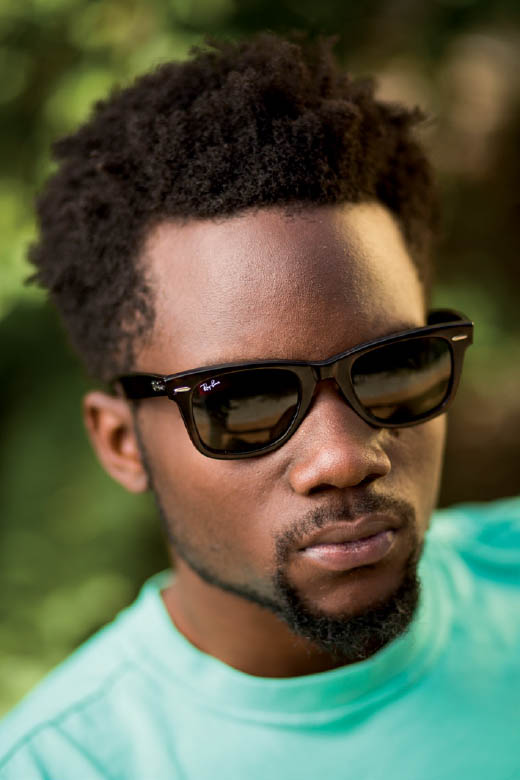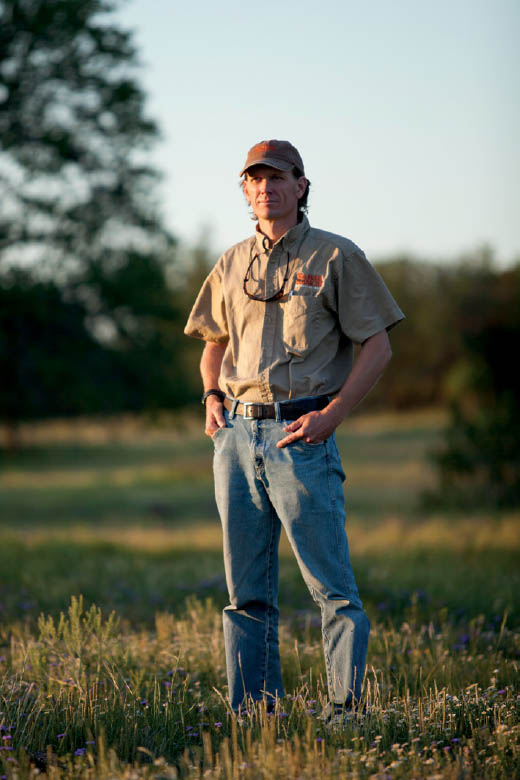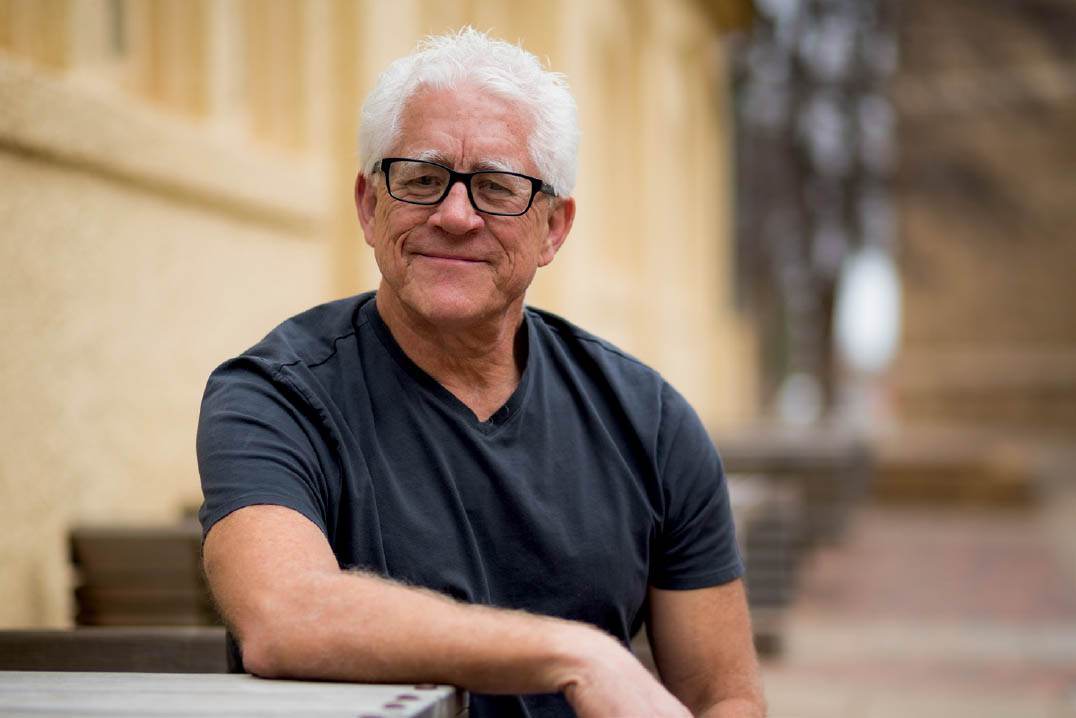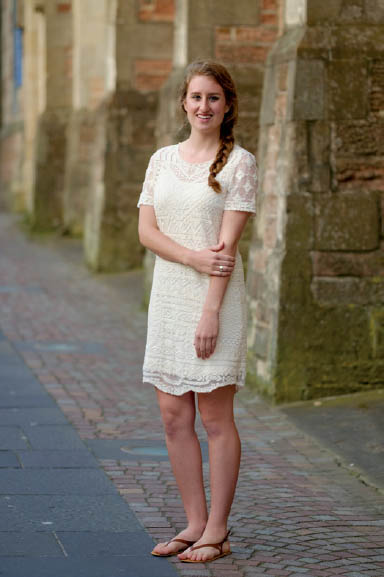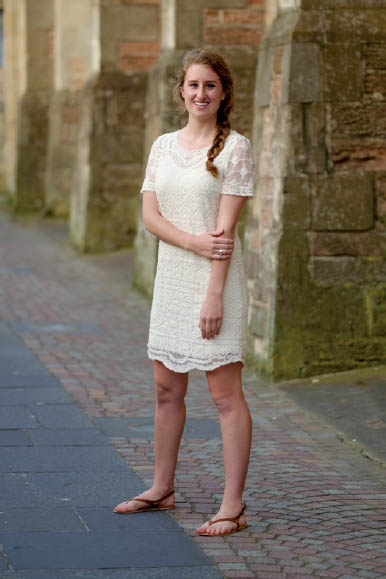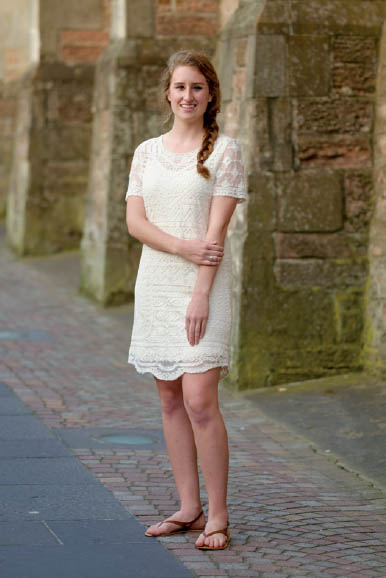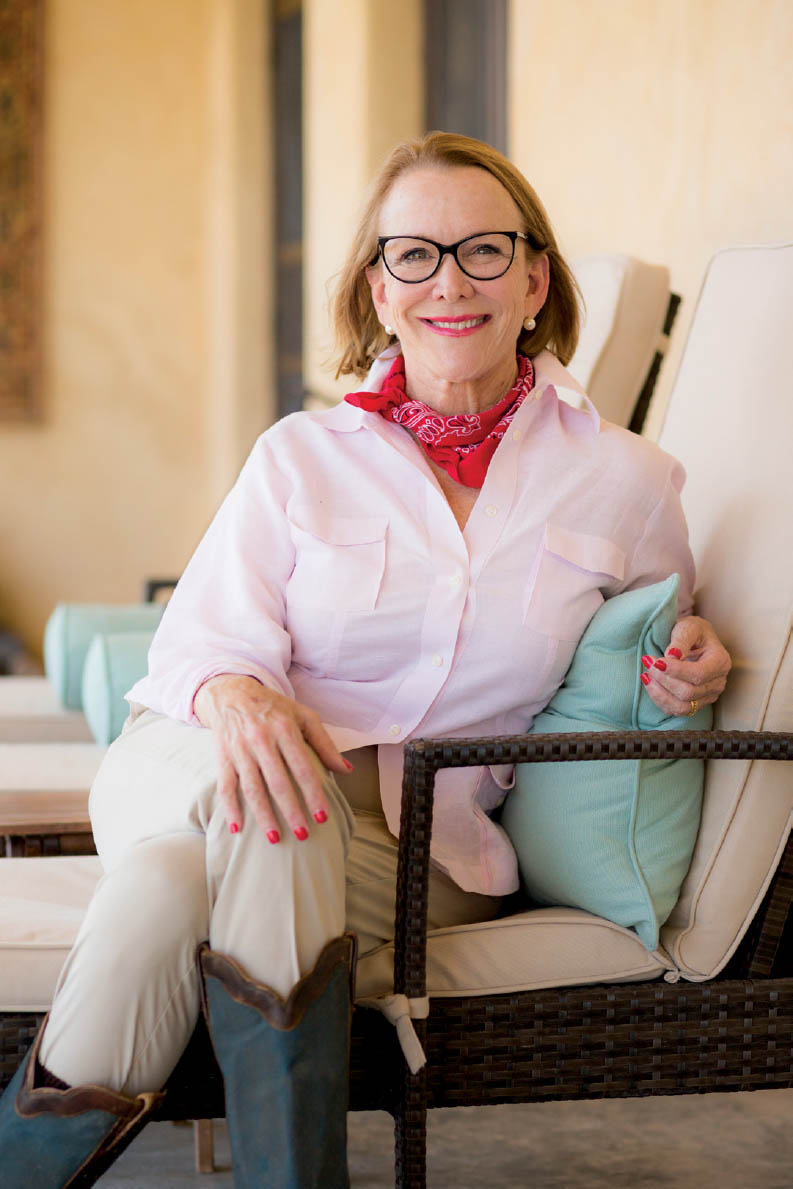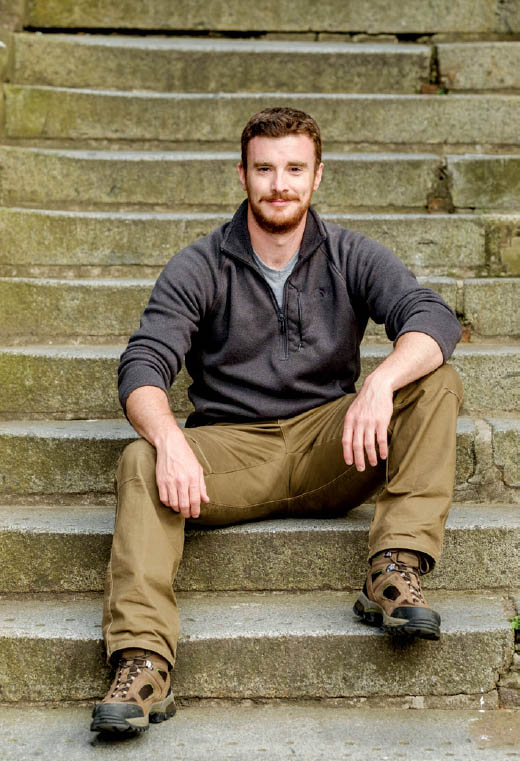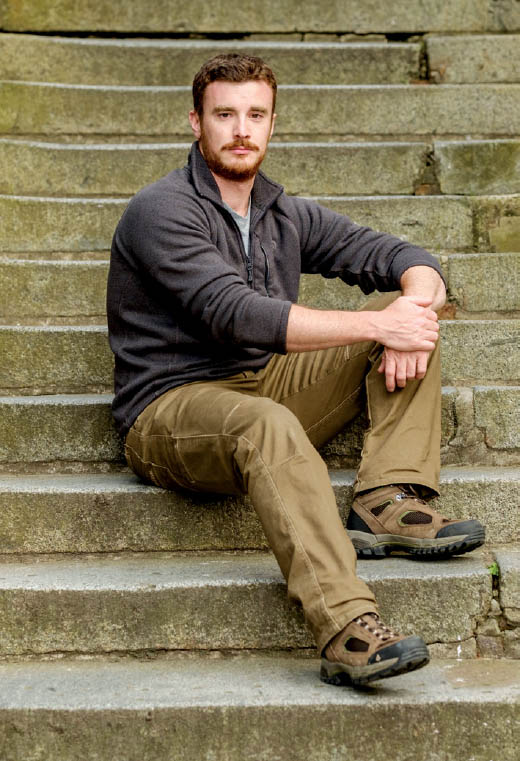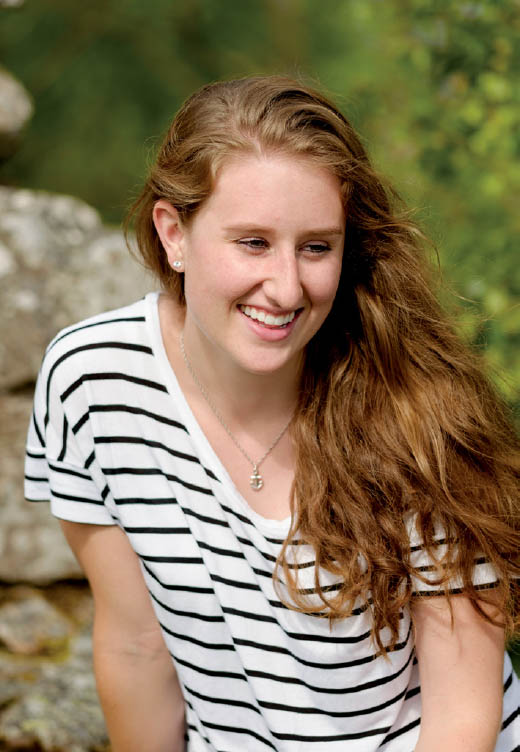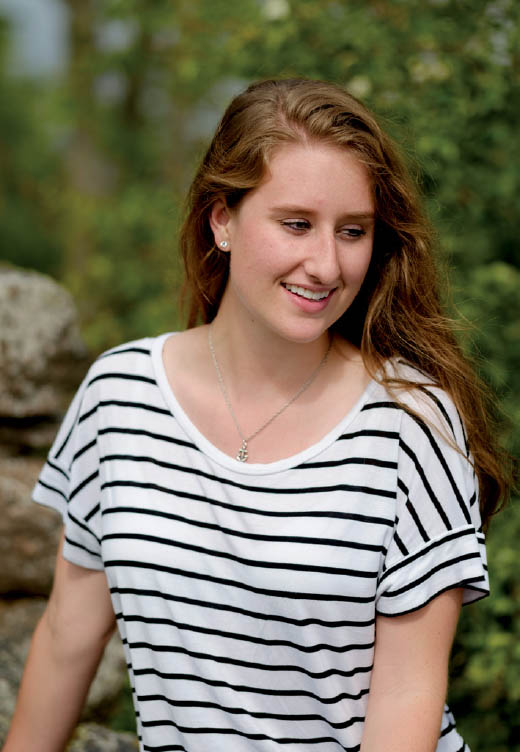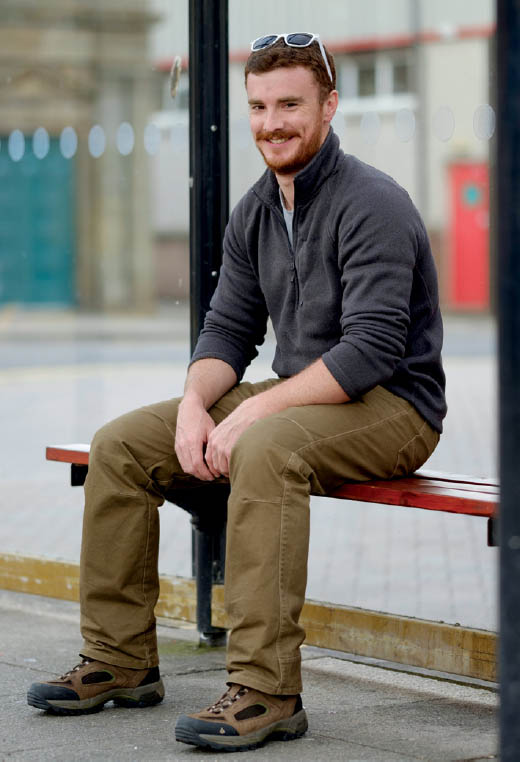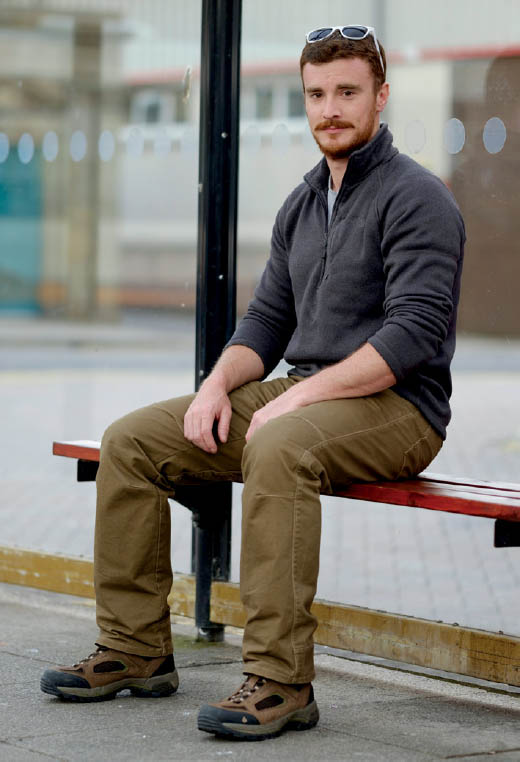42. STANDING VS. SITTING
![]()
BOTH STANDING AND seated poses are great, but depending on the type of portrait you want to shoot, one might be more suitable over the other. For example, corporate headshots are often shot with the subject sitting, while senior portraits involve a mixture of standing and sitting, and environmental portrait postures are often narrative dependent. It’s good to keep a few considerations for posing both standing and sitting subjects filed away when on any shoot.
For standing and sitting subjects alike, it’s visually attractive to pose the subject so that their shoulders are more or less uneven (Figure 42.1). Aside from straight-on shots, angling your subject’s orientation to the camera is a great way to do this. For standing subjects, especially males, turning the body slightly away from the camera and placing their hands in their pockets helps loosen up the shoulders (Figure 42.2). By creating an uneven shoulder posture, you essentially create a small (or large, depending on how tight your frame is) line of interest that increases the visually dynamic appeal of your subject. Have sitting subjects position one arm behind them while draping the other across their lap to accomplish a similar line. It might be a simple, very small change you think you’re making when you alter poses, but it will render a nice appeal for the portrait.
It’s also a good idea for both standing and sitting subjects to lean toward the camera (Figure 42.3). It might be natural for some subjects to shy away from the camera physically, but when they lean slightly toward the camera, they become more engaging subjects. They don’t have to lean too far toward the camera, just enough to avoid looking like they are afraid of the portrait process.
For standing subjects, take into account the spacing of their feet (generally, it’s a good idea to start the feet a shoulder’s width apart). You can augment the spacing as you see fit, but you’ll notice the subject may look more awkward the wider their feet are (Figure 42.4, Figure 42.5, and Figure 42.6). It is also a good idea to place one foot more forward than the other. This is especially important when you are orienting your subject at an angle to the camera. Placing one foot more forward than the other allows the subject to relax on the foot in the back, creating a casual, comfortable, and confident-looking posture (Figure 42.7). This also contributes to the compositional line of the body, especially in full-length portraits.
For the most part, a seated subject decreases the portrait’s formality. Of course, this depends on the intention of the portrait, the environment, and how the subject is dressed (Figure 42.8). However, even a man in a tuxedo sitting in a luxuriously appointed room can be made to look casual. So, sitting your subject down can be not only a great way to provide him another posing perspective, it can also increase how relaxed the image feels to a viewer.
42.1 For this headshot, I posed the sitting subject in a way that his shoulders create an attractive diagonal line across the frame, which moves the eye upward to and across his face.
ISO 200; 1/2500 sec.; f/1.8; 85mm
42.2 Coaching the subject to place his hands in his pockets physically garnered a slight dip in the subject’s right shoulder, subtly conveying in tandem with the hands a more relaxed state for this rural resort owner and operator.
ISO 100; 1/640 sec.; f/2.8; 200mm
42.3 A great way to create more engagement with your portraits is to have the subject lean slightly toward the camera as opposed to shying away from it.
ISO 100; 1/2000 sec.; f/1.8; 85mm
42.4 Legs that are placed too close together might convey nervousness.
ISO 400; 1/640 sec.; f/2; 90mm
42.5 A stance wider than shoulder width will increasingly look more awkward for the subject.
42.6 It’s often best to place a subject’s feet about shoulder width apart, which is both comfortable for the subject and not visually disconnected for the viewer.
42.7 At the same time I encourage the subject to place their feet shoulder width apart, I also suggest moving one foot slightly forward and leaning back on the other. This can visually increase a subject’s relaxed mood or personality.
42.8 In a feature on Katharine Love’s life in the Texas Big Bend, I wanted to create a portrait of her on her back porch, which opens up to the Santiago Mountains forming the north border for Big Bend National Park. Sitting in one of her favorite places to relax seemed more than appropriate for the shot.
ISO 400; 1/1600 sec.; f/2.8; 85mm
That being said, there are a few things to avoid when shooting subjects who are sitting. The first thing to stay away from is the dreaded “crotch shot.” This occurs when you position a sitting subject so their body faces the camera directly (Figure 42.9). When the subject sits like this, we shoot into their legs, which creates an unflattering posture. The solution? Simply angle your subject away from the camera a bit (Figure 42.10). For some subjects and camera angles, crossing your subject’s legs might also eliminate this issue, as might your subject leaning forward on his legs and holding his hands together (Figure 42.11). It is best to cut down on photographing your sitting subjects straight on, or at least when you are framing the shot to include all of their body.
For many sitting shots of female subjects, it is common to pose them leaning back on one or both of their arms. Although this is a very casual, playful pose, it is important to not have them lean back too heavily for fear that their arms and shoulders will flex too much. When a subject in a short sleeve or sleeveless shirt or dress uses her arms to support her when she leans back, her triceps appear under strain. Although this may not be an unattractive visual, this flexing more than likely will make her arm(s) appear larger than they are naturally. On top of that, leaning back with too much weight will also push the shoulder up and forward, potentially covering up the neck and parts of the face (Figure 42.12). Instead, coach the subject to ease up on the amount of weight they place on their arm(s) as they lean back (Figure 42.13). Tell them why you want them to and they’ll more than likely appreciate it. I sometimes joke that it will feel like they’re getting a small abdominal workout, but it will most certainly improve their posture and the overall look of the portrait.
On the subject of posture, don’t let your subject slouch or hunch unless it is an essential part of the portrait’s message. We’ve all been instructed at one point in our lives that slouching is both anatomically bad for us as well as unprofessional. Slouching should be avoided for both sitting and standing subjects, but it seems to be more prominent in sitting portraits (Figure 42.14 and Figure 42.15). Coach your subject to sit up without becoming uncomfortable. Casual portraits do not look good with stilted posture, but there is much to improve upon the common slouch. For example, when your subject is leaning forward on his knees, ask him to raise his head up a bit. This will correct for an over-exaggerated hunch and make him look more alert, as well as more dominant. Instead of having someone sit slouched into a bench, have them sit up a bit while also putting an arm on top of the bench’s back. This will force their posture up and they will lean toward the camera.
42.9 The “crotch shot” is both visually obvious in definition and something definitely worth avoiding.
ISO 400; 1/350 sec.; f/2.8; 90mm
42.10 One way to avoid shooting into the legs is to simply turn the subject away from directly facing the camera.
42.11 If I want the subject facing the camera while avoiding the “crotch shot,” I often coach the subject to place their hands together forward of and in front of the sensitive area.
42.12 Try to avoid having your subject lean back on one or both of their arms with all their weight. It more than likely will force their shoulders up to an awkward position relative to their face and neck, and it will make the subject appear as if they are flexing their triceps.
ISO 200; 1/3000 sec.; f/2; 90mm
42.13 Coach your subject to ease up on their arms. They will still appear as if they are leaning back, but they will hold their weight off of their arm, moving the awkwardly placed shoulder lower, providing a more defined and trim neckline, and reducing the amount of flex in their rear arm.
42.14 A slouching subject can often sneak up on you in the edit after the shoot. Be cognizant of how your subject naturally poses or holds himself when you start shooting.
ISO 200; 1/420 sec.; f/2; 90mm
42.15 Coach the subject to straighten up their form. This does not have to be drastically formal, but a more upright position, as opposed to slouching, makes the subject appear more active, professional, and positive.

